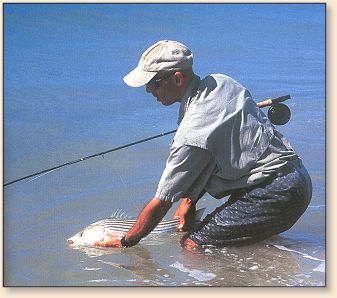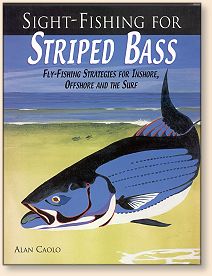The diversity of our fly fishing world is expanding.
Rapid technological development and hard work by
innovative sportsmen over the last decade have
provided fly fishers with a vast array of modern
tackle, advanced techniques and worldwide angling
opportunities. The most dramatic growth has been
in salt water where changing attitudes on the part
of sportsmen have led to unprecedented popularity
in saltwater fly fishing.
The game fish sought by today's fly fishers are perhaps
the best evidence of this growth. With the "bait and
switch" techniques and some very high-tech equipment
nearly all the blue water species are routinely taken
now on fly gear. False albacore and bonito have become
widely sought after inshore game fish albeit for decades
only a few fly-rodding mavericks pursued them.
Exciting things are happening on the flats as well.
Several innovative Northeast anglers and guides have
begun exploring flat-fishing opportunities at
home - for striped bass. Long thought
to be exclusively a tropical experience, the successful
introduction of southern-style flats-skiffs for stalking
stripers on Northeast flats has proven otherwise. In
a short time, fly-rodding for stripers has experienced
a popular shift from traditional approaches. At the
apex of the sport today is sight-fishing, where visual
excitement and challenge provide fly fishers a thrilling
and rewarding experience.

Stripers are superb flats game fish and they're readily
available to many fly-fishers. When striper stocks are
up the sight-fishing opportunities are endless. When
their numbers are down, sight-fishing is perhaps the
most effective way of catching one of fly tackle.
They offer a spectrum of challenge to suit the
expectations of all fly fishers. The school-fish
commonly associated with easy-to-fish inshore flats
offer moderate challenge for beginners and casual
sight-fishers. Experience fly-fishers looking for
a tougher challenge find the large, sophisticated
fish on offshore flats more appealing. For anglers
seeking trophy fish in a high-skill environment, the
surf offers the "major league" experience. For some
fly-fishers, sight-fishing is an exciting alternative
during the hot summer months after the spring migration
has evaporated and the fall migrations is still months
away. For others it is an obsession, where the fast
action of spring and fall become the bookends to the
preferred sight-fishing season. And for winter bonefish
junkies in search of an off-season fix, stalking stripers
in skinny water is a welcome surrogate. Stripers, however,
are much closed to home for most of these folks, and no
plane tickets or passports are required for a quick trip
to the Northeast flats.
Visually stalking game fish with fly tackle is not new.
Early fly-fishers began by casting dry flies to rising
trout centuries ago, and the sport remains as challenging
and as popular today. In salt water, anglers have been
sight-fishing for bonefish, tarpon, and permit for decades
and the immense popularity of this sport has ignited an
entire industry throughout the tropics. In light of the
challenges involved and the potentially overwhelming
complications of adverse weather, third-world destinations,
Miami International, hostile natives, sharks, toxic sea-life,
and more, it may seem puzzling that anglers the world over
ardently pursue this brand of fly fishing (at great expense,
mind you).
To pinpoint sight-fishing's vast appeal is difficult.
Visual excitement, mental absorption and
challenge immediately come to mind - but
it may be more than that. Most game fish we stalk on
the flats may be pursued in other ways. Look at the
addiction we call bonefishing. Albula vulpes
can be easily taken off the flats in deep water with
some ground shrimp and a little patience. Even a
blind-folded first-timer can catch a trophy bone this
way. But very few people do it, and fly-fishers don't
even consider it.
Sight-casting to the Silver King [tarpon] is even more
confounding. Talk about a low percentage endeavor! Yet,
countless tarpon skiffs dot the Florida Key's horizon
each spring with anxious anglers vying for the thrill
of casting to those magnificent fish.
Sight-fishing appeals to many anglers simply because
everything that takes place between you and your quarry
is witnessed. Somewhat of a double-edged sword, this
can be a euphoric angling triumph, or a frustrating
bout of rejection. How easy it is while blind-casting
to presume that there are no fish where you are when
the strikes do not come. It is indeed the rare angler
who remains objective and assumes nothing in these
circumstances. Sight-casting, on the other hand,
provides the luxury of knowing this part of the puzzle
without doubt. It also provides you the knowledge that
you've done everything right, or that you have not.
Less obvious is the combination of primordial instincts
to fish and hunt, which is so perfectly provided with
sight-fishing. Such a combination preoccupies the mind
to produce a focused and continuous involvement. Even
when the fish are not cruising in your view and your
fly is still in hand - you are stalking them,
and opportunity may prevail at any moment. Presenting
to a mere 10 fish throughout a three-hour span is easily
perceived as solid action.
The intensity and excitement of this sport if thrilling.
While sight-fishing, anglers encounter their quarry on
its terms, and they must perform on cue. This is
challenging fishing, and casting skills must be above
average. Unlike blind-casting, sight-casting offers
little choice as to cast directions, distance, and
timing. Consistently successful sight-fishers are
above all else, calm and competent fly-casters.
Competent casting is consistently accurate, smooth,
long when necessary, immune to adverse wind direction,
and is only achieved through practice. Calm fly-casting
is the ability to continue casting competently when the
fish are in sight. Since the fish usually appear
suddenly and are often moving quickly, the excitement
can cause many sight-fishers to react frantically and
fail to make a good cast. Staying calm with a trophy
striper appears in your casting range is not easy, but
it is a skill that must be developed to make the most
of the opportunities your work to create. As with
tarpon and bonefish, calm casting is acquired through
experience. Even the veterans get excited with the
sight of a great fame fish on the flats. It wouldn't
be much fun if you didn't. They stay cool, however,
and make the cast that gets the fish. Only saltwater
sight-fishing offers this angling intensity and excitement.

Much like bonefishing, consistent success stripers on
the flats comes to those who pay attention to detail.
There are no "magic dart" flies; there is just doing as
many little thing right as often as you can. That is
the challenge. The ability to see everything that takes
place - the fish's movements, its reaction to the fly, a
follow, a refusal, or a take, are not only exciting to
witness, but the analysis of these observations and
subsequent adjustment on your part are at the heart
of the sport. The ultimate solid hookup is thrilling,
as it is head-shaking, reel-screaming proof that you
have done everything right. You should
rightly feel proud of every striper hooked while
sight-fishing. Each one is an accomplishment. Most
veteran sight-fishers insist they would rather take
one bass by sight than 10 or 15 any other way. How
do I feel about it? I rarely fish blind for them
any more. ~ Alan Caolo
Credits: Excerpt and photo from Sight-Fishing
for Striped Bass Fly-Fishing Strategies for Inshore,
Offshore and the Surf, by Alan Caolo, Published by Frank
Amato Publications. We appreciate use permission. |


